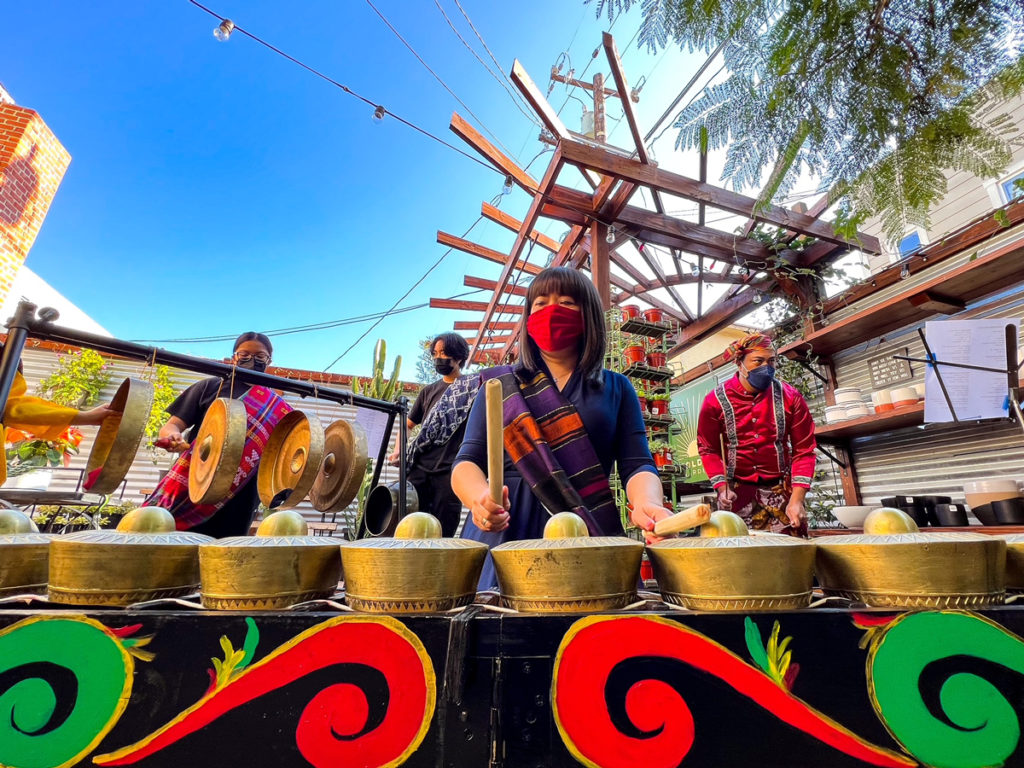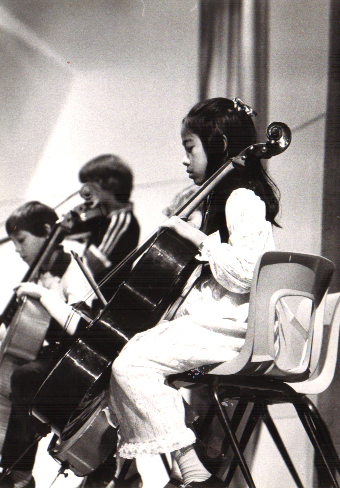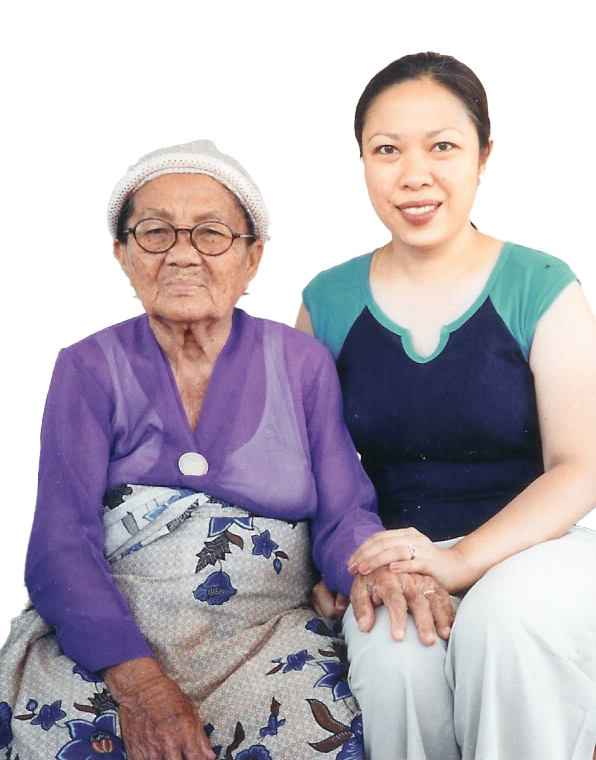Connecting With
Culture Through Music
Mary Talusan Lacanlale uses music to share Filipino history and culture with a younger generation.
Assistant Professor of Asian-Pacific Studies Mary Talusan Lacanlale has long found music to be the route through which she has connected with her Filipino history, roots, and culture. Through her scholarship as an ethnomusicologist, she helps pass that connection on to the next generation of Filipino Americans.
Lacanlale’s parents were doctors who immigrated from the Philippines in the 1970s to help fill the need for medical practitioners, settling in the suburbs of Boston, Mass. “My parents were busy,” she recalls. “They had very little time and, to be honest, little interest in educating us about the Philippines. They spoke English, so we spoke English. They were very Americanized.”
In Massachusetts public schools, she had little access to Filipino culture or history. But visits from her grandmother helped keep that connection alive. “My grandma would visit from the Philippines every other year and stay with us for a couple of months,” recalls Lacanlale. “She was my only connection to Filipino culture, as well as my own history. She would close her eyes and tell us these fantastic stories about how her father—my great-grandfather—was a famous band musician, how he came to the U.S. many times to perform in symphony halls in New York, Boston, and Chicago.”
Her grandmother’s tales ignited a spark in the young musician, who had been playing the cello since the age of 10. “This is where my knowledge of the Philippines and my passion for music come together, because I wanted to know more about Philippine history through music.”
Her passion for discovering Filipino culture through music took her on an educational journey from the New England Conservatory of Music to UCLA to Tufts University, with stops at Tulane University and the Peabody Conservatory of Music in between. She joined the faculty at CSUDH in 2011, where she teaches a variety of courses in the Asian-Pacific Studies Program.
Two of the professor’s long-term projects came to fruition in 2021, both of which examine Philippine history through a musical lens. Her book, Instruments of Empire: Filipino Musicians, Black Soldiers, and Military Band Music during U.S. Colonization of the Philippines, was published in August. That same month also saw the release of a CD she co-produced for Smithsonian Folkways Recordings, Kulintang Kultura: Danongan Kalanduyan & Gong Music of the Philippine Diaspora.
The book is the culmination of 20 years of research—having been sparked by her grandmother’s musical tales. Lacanlale’s great-grandfather was a member of the Philippine Constabulary Band, a collection of Filipino musicians originally formed in 1902. They toured the world for several decades as a propaganda tool of the U.S. government, helping convince audiences that the American colonization of the Philippines was worthwhile and just. Lacanlale also highlights how the band resisted this role by performing as soloists and playing works by Filipino composers to express their own identities. The band dissolved at the outset of World War II, and its history was all but forgotten in the U.S.

We want to keep teaching the younger generation about this and giving them access to it. I’m really excited about that. That’s where my work really collides with my life story and the passion that I have for education and learning through music.
– Mary Talusan Lacanlale
Her graduate school research project on the band became a side project that Lacanlale worked on during summer breaks and when grant funding allowed. She discovered that her grandmother was right—in 1916, Lacanlale’s great-grandfather Pedro Navarro became the band’s first Filipino conductor. He excelled in the role, even receiving praise from legendary bandleader John Philip Sousa.
In the course of her work, Lacanlale found that the Constabulary Band had been assembled specifically to promote American colonization. An African American army officer named Walter Loving was appointed by then-Governor General of the Philippines William H. Taft to lead the band, and he scoured the islands for musicians to fill out the roster.
“This Filipino band was sent to all of these states and several world’s fairs to project an image of the Philippines that legitimized U.S. colonization,” says Lacanlale. The U.S. government brought over 80 Filipino band members to tour the states on multiple occasions.
“Filipinos had been playing Western music for at least 150 years before the U.S. got there,” says Lacanlale. “Of course, the U.S. promoters didn’t highlight that fact, so American audiences watching them in these lavish symphony halls thought, ‘Oh my God, we took them from being total savages who had no idea what western instruments were to these superb classical musicians in just a few years!’”
In truth, because coveted band positions were often handed down from father to son in the Philippines at the time, most of the Constabulary Band had been playing similar music for generations. But to American audiences of the time, they represented tribesman who had been ‘civilized’ by the influence of the U.S.
“Of course, it seemed miraculous,” she says. “‘In just a few years, we created this symphony!’ It was an amazing tool to promote the success of U.S. colonization.” Lacanlale chose the book’s title to reflect this fact. “They were ‘Instruments of Empire’ because they were used to prove to the American public that ‘civilizing’ Filipinos was possible.”
The CD she co-produced for Smithsonian Folkways was another labor of love. It focuses on kulintang, a form of gong and drum music indigenous to the Maguindanao Muslim culture of the southern Philippines. Because it originates in islands that were never brought under Spanish rule, the music retains its pre-colonial traditions.
Much of the album serves as a tribute to the late kulintang master Danongan “Danny” Kalanduyan, who taught and played the music in the U.S. for over four decades. He is revered in Filipino music circles for preserving kulintang heritage and passing it on to future generations. Lacanlale and her co-producer, Theo Gonzales, structured the two-disc set to reflect his legacy.
The first disc of the double album features Kalanduyan and his ensemble performing 24 traditional kulintang songs. They showcase kulintang as it has been played for generations by women, as well as a newer, faster style in vogue since the 1950s, when more men started playing the music. The second disc represents the influence of Kalanduyan’s advocacy and teaching—it features 13 modern tracks that incorporate kulintang elements.
“Many of the musicians on the second disc were Danny’s students, most of them Filipino American,” says Lacanlale. “They learned traditional kulintang from him, then incorporated it into their own music. They have taken kulintang in new directions.”
The result is an eclectic mix of genres, from hip-hop and electronica to jazz and hard rock. “It still has a recognizable connection to a musical culture that’s rooted in the Philippines. It’s so cool to hear these new works, and the ways that young Filipino musicians are keeping the music alive.”


